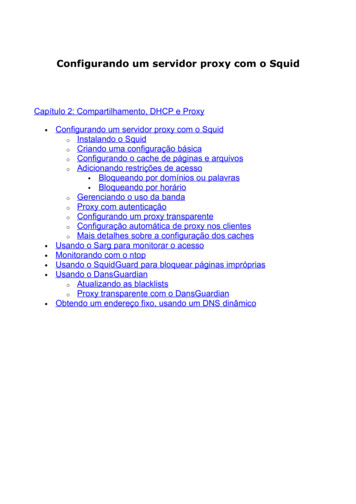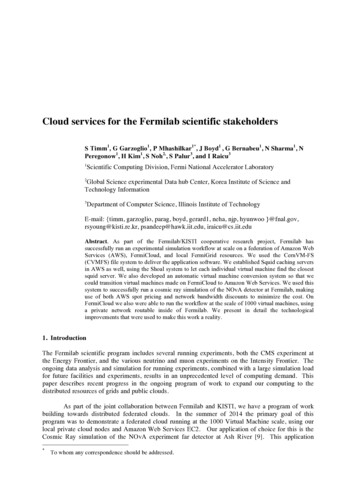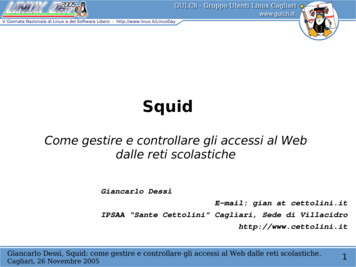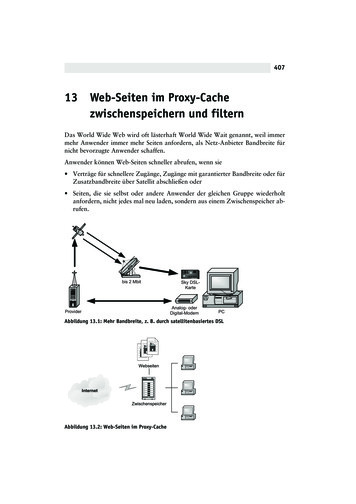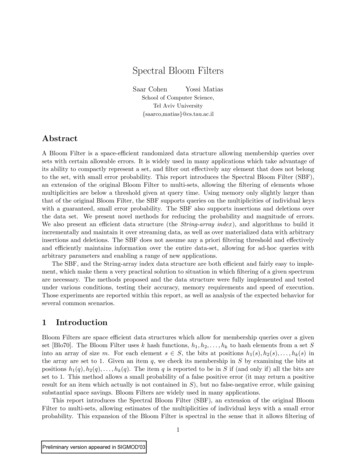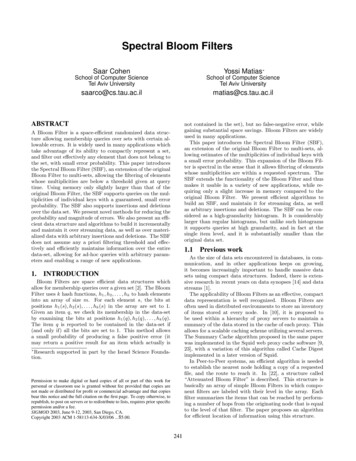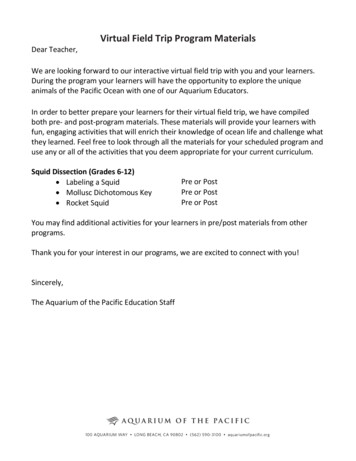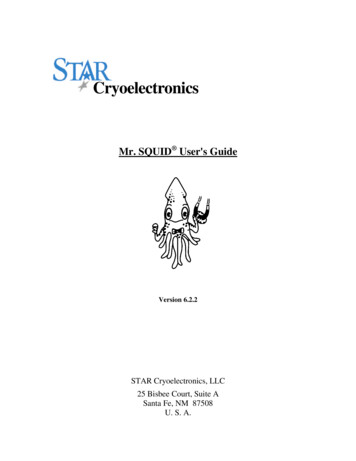
Transcription
CryoelectronicsMr. SQUID User's GuideVersion 6.2.2STAR Cryoelectronics, LLC25 Bisbee Court, Suite ASanta Fe, NM 87508U. S. A.
Mr. SQUID User's GuideManual written byRandy W. Simon, Michael J. Burns, Mark S. Colclough,Greg Zaharchuk, and Robin CantorAdvanced Experiments written byMichael J. Burns (Exp. 1-5 and 7) andGreg Zaharchuk (Exp. 6)Mr. SQUID is a registered trademark of STAR Cryoelectronics, LLCCopyright 1996 – 2004STAR Cryoelectronics, LLCiii
Mr. SQUID User’s GuideTABLE OF CONTENTSTechnical Support . viWarranty . viiSafety Precautions. vii1Introduction. 12Setting Up Mr. SQUID . 53452.1What You'll Need. 52.2Assembling the Mr. SQUID System. 6Getting Started with Mr. SQUID (New Users). 103.1Setting Up the Output Device . 103.2Varying the Current Bias . 113.3Varying the Amplitude of the Current Sweep . 113.4Calculating the Current . 123.5The V-I Curve . 123.6Observing V-Φ Characteristics using Mr. SQUID . 153.7Modulating the Critical Current of the SQUID . 153.8Additional SQUID Measurements. 183.9Summary of Basic Experiments. 21Getting Started with Mr. SQUID (Advanced Users) . 234.1Electronics Box Front Panel . 234.2Electronics Box Rear Panel . 244.3Basic Operation. 254.4V-Φ Characteristics. 26An Introduction to Superconductivity and SQUIDs. 275.1A Capsule History of Superconductivity . 275.2Superconductivity: A Quantum Mechanical Phenomenon. 275.3The Superconducting State . 275.4The Quantum of Flux. 285.5Superconducting Rings . 295.6Josephson Junctions . 305.7The dc SQUID . 315.8Details of dc SQUID operation. 32STAR Cryoelectronics, LLCiv
Mr. SQUID User’s GuideSQUID Parameters. 365.10SQUID Operation . 385.11Practical SQUID Magnetometers . 395.12SQUID Applications. 415.13A Brief History of SQUIDs . 425.14The SQUID in Mr. SQUID . 4465.9Troubleshooting and Getting Help. 46Problems in V-I Mode. 476.2Problems in V-Φ Mode (Assuming Everything Works in V-I Mode) . 486.3Magnetic Flux Trapping in SQUIDs. 496.4Degaussing the Magnetic Shield. 506.5RF Interference . 506.6Customer Service . 5276.1Advanced Experiments . 547.1Resistance vs. Temperature of the YBCO SQUID . 557.2Building an Analog Flux-Locked Loop. 627.3Using a Flux-Locked Loop as a Sensitive Voltmeter . 667.4The ac Josephson Effect: Microwave-Induced (Shapiro) Steps at 77Kand Determining h/e. 707.5Inductive Measurement of the Superconducting Transition Temperatureof an HTS Film . 777.6SQUID Properties in Pumped Liquid Nitrogen . 847.7Building an 8-bit or 12-bit Digital Flux-Locked Loop . 888About STAR Cryoelectronics . 1089Technical Specifications . 109Electronics. 1099.2Probe . 1099.3Magnetic Shield . 1099.4RF Filter Module. 1109.5Cable . 1109.6Dewar. 110109.1References. 111STAR Cryoelectronics, LLCv
Mr. SQUID User’s GuideRevision RecordDateRevisionDescriptionJuly 17, 20006.1January 11, 20026.1.1April 26, 20026.2Updated specificationsMay 10, 20026.2.1Updated specificationsAugust 8, 20036.2.2Updated specificationsSTAR Cryoelectronics ReleaseUpdated contact informationCopyright 2000 – 2002 by STAR Cryoelectronics, LLC, Santa Fe, NM 87508All rights reserved. No part of this manual may be reproduced, stored in a retrieval system, ortransmitted in any form or by any means, electronic, mechanical, photocopying, recording, orotherwise, without prior written permission of STAR Cryoelectronics.STAR Cryoelectronics reserves the right to change the functions, features, or specifications of itsproducts at any time, without notice.TECHNICAL SUPPORTIf you have any questions or comments about this product or other products from STARCryoelectronics, please contact:STAR Cryoelectronics25 Bisbee Court, Suite ASanta Fe, NM 87508U. S. A.http://www.starcryo.com/Technical Support:Tel.:FAX:Email:STAR Cryoelectronics, LLC(505) 424-6454(505) 424-8225info@starcryo.comvi
Mr. SQUID User’s GuideWARRANTYSTAR Cryoelectronics Limited WarrantySTAR Cryoelectronics warrants this product for a period of twelve (12) months from date oforiginal shipment to the customer. Any part found to be defective in material or workmanshipduring the warranty period will be repaired or replaced without charge to the owner. Prior toreturning the instrument for repair, authorization must be obtained from STAR Cryoelectronicsor an authorized STAR Cryoelectronics service agent. All repairs will be warranted for only theunexpired portion of the original warranty, plus the time between receipt of the instrument atSTAR Cryoelectronics and its return to the owner.This warranty is limited to STAR Cryoelectronics products that are purchased directly fromSTAR Cryoelectronics, its OEM suppliers, or its authorized sales representatives. It does notapply to damage caused by accident, misuse, fire, flood or acts of God, or from failure toproperly install, operate, or maintain the product in accordance with the printed instructionsprovided.This warranty is in lieu of any other warranties, expressed or implied,including merchantability or fitness for purpose, which are expresslyexcluded. The owner agrees that STAR Cryoelectronics’ liability withrespect to this product shall be as set forth in this warranty, andincidental or consequential damages are expressly excluded.SAFETY PRECAUTIONSDo remove product covers or panels except for modifications as specified in this manual.Do not operate without all covers and panels in place.Do not attempt to repair, adjust, or modify the instrument, except for modifications as specifiedin this manual. This could cause nullification of any warranty. For service, return the instrumentto STAR Cryoelectronics or any authorized representative.Do not operate this instrument in a volatile environment, such as in the presence of anyflammable gases or fumes.The liquid nitrogen dewar provided with Mr. SQUID is accompanied by instructions fromthe dewar manufacturer. The user is responsible for the observance of the manufacturer’sdirections, warnings and restrictions.STAR Cryoelectronics, LLCvii
Mr. SQUID User’s GuideCongratulations!You have just purchased the world's first high-temperature superconductive electronic systemproduct: Mr. SQUID , originally developed by Conductus and now offered exclusively bySTAR Cryoelectronics. Contained within its cryogenic probe is an integrated circuit chipincorporating a high-temperature superconducting quantum interference device (SQUID). Thisaffordable instrument system will allow you to observe several of the unique features ofsuperconductivity without the complications of liquid helium cooling and without specializedequipment or facilities. In addition, Mr. SQUID will allow you to learn about the operation ofSQUIDs by following a series of experiments that can be readily performed in undergraduatelaboratories.Mr. SQUID is a First Mr. SQUID is the first electronic instrument on the market that incorporates hightemperature superconductor (HTS) thin film devices. Mr. SQUID is the first commercial use of liquid nitrogen cooled SQUID technology. Mr. SQUID is the first instrument for the demonstration of the quantum effects ofsuperconductors designed for undergraduate laboratories.About This ManualMr. SQUID is designed to assist in the education of young scientists in training. Every efforthas been made to try to make this manual as readable and accurate as possible. All of theexperiments were performed multiple times before their manual sections were written.Considerable effort has been made to make this product and manual as valuable and easy to useas possible. Just as in performing cutting edge research, however, difficulties performing theexperiments in this manual can arise and the apparatus may become uncooperative. Weencourage you to contact us if you encounter problems that appear to be insurmountable, or tomake suggestions or to point out errors so that we may improve this product and this manual.The best way to contact us is by email at info@starcryo.com. Other means of contacting usabout this product are described in the troubleshooting section of this manual.STAR Cryoelectronics, LLCviii
Mr. SQUID User’s Guide1INTRODUCTIONWhat is Mr. SQUID ?Mr. SQUID is a dc Superconducting QUantum Interference Device (SQUID) magnetometersystem incorporating a high-temperature superconductor (HTS) thin film SQUID sensor chip,normal metal coils for modulation and external coupling, a cryogenic probe with a removablemagnetic shield, a cable to hook up the probe, and a battery-operated electronic control boxcontaining all the circuits needed to operate the SQUID. The probe is designed to be immersedin a liquid nitrogen bath in the enclosed dewar flask. The user must supply the liquid nitrogen.The only additional equipment required for the basic operation of Mr. SQUID is either anoscilloscope or an x-y recorder to display the output signals from the control box.What's Inside the Probe?At the heart of Mr. SQUID is a small integrated circuit chip whose main components are a dcSQUID and two modulation coils. The SQUID is made of yttrium barium copper oxide(Y1Ba2Cu3O7, sometimes called YBCO or “1–2–3” after the ratio of the metals in the compound)that is fashioned into a ring containing two active devices called Josephson junctions. Thedevices and structures on the chip are created using the same photolithographic steps that areused in the integrated circuits (IC’s) that dominate today’s conventional electronic devices.What does Mr. SQUID do?Mr. SQUID is an HTS dc SQUID magnetometer and can therefore be used to detect smallmagnetic signals if they are properly coupled to the SQUID. Because its modulation coils arenot superconducting, Mr. SQUID does not have the sensitivity of high-performance laboratorySQUIDs and cannot be used to detect truly minute signals such as those generated by the humanbrain. On the other hand, Mr. SQUID is designed to demonstrate all the principles behindSQUID applications. In this user's guide, we describe a number of experiments – some simple,others more complicated – that allow you to explore the operation and the uses of SQUIDs.The Basic FunctionsThe Mr. SQUID control box contains the necessary amplifiers, current drivers, and switches toallow you to observe and investigate two basic phenomena of SQUIDs and Josephson junctionswithout any additional experimental apparatus apart from an output device (an oscilloscope or xy recorder) and a supply of liquid nitrogen.1) Voltage-current characteristics: The Mr. SQUID control box will allow you to observethe voltage-current (V-I) characteristics of the SQUID (which consists of two Josephsonjunctions connected electrically in parallel). Without liquid nitrogen cooling, the V-Icharacteristic of the SQUID will be a straight line, because the junctions behave likeordinary resistors. Once the junctions are cooled, the non-linear shape you will see onthe oscilloscope screen or x-y plotter indicates the presence of a resistanceless currentthrough the Josephson junctions. The details of the shape are described later in this user'sguide. In this mode, Mr. SQUID allows you to observe directly the dc Josephson effect,the basis of many circuit applications of superconductivity.2) Voltage-flux characteristics: The Mr. SQUID control box also will allow you toobserve the voltage-flux (V-Φ) characteristics of the SQUID. As we will explain in detaillater, applying an external magnetic field to a dc SQUID causes the voltage across theSTAR Cryoelectronics, LLC1
Mr. SQUID User’s GuideSQUID to change periodically as the field is varied. The periodicity of the voltagemodulation is governed by a fundamental quantity known as the magnetic flux quantumor "fluxon." Briefly, the voltage undergoes a complete cycle of modulation each time aquantum of flux passes through the superconducting loop that comprises the SQUID.Since magnetic flux is the product of magnetic field times area, the magnetic field periodof these voltage oscillations is determined by the geometry of the SQUID. This is afundamental property of superconducting rings and SQUIDs that Mr. SQUID allowsyou to investigate. The Mr. SQUID control box allows you to apply an externalmagnetic field to the SQUID and to vary that field in a way that is convenient for displayon an oscilloscope or x-y recorder.Obtaining the V-I and V-Φ curves are the essential elements of SQUID operation and are thestarting point for working with Mr. SQUID . Later in the user's guide, in Section 7, we willoutline a series of more advanced experiments using Mr. SQUID that demonstrate howSQUIDs can be used for a variety of applications as well as for observations of the properties ofmaterials. Until Mr. SQUID , the only superconducting property that was easy to demonstratewas magnetic flux expulsion using a levitated magnet. Now, with Mr. SQUID , other aspects ofsuperconductivity can be observed in any laboratory.Demonstrating the Hallmarks of SuperconductivitySuperconductivity is a unique property of certain materials that gives them remarkableadvantages as electric conductors, magnetic shields, sensors, and as elements of advancedintegrated circuits. The three primary hallmarks of this phenomenon are:1) Zero resistance to the flow of dc electrical current,2) The ability to screen out magnetic fields (perfect diamagnetism),3) Quantum mechanical coherence effects – magnetic flux quantization and the Josephsoneffects.Until 1987, none of these effects could be observed without a liquid helium-cooled cryostat and,in general, fairly elaborate instrumentation. This was because all known superconductorsbecame superconducting only at temperatures below 23 K (-250 C) and more typically below 10K. In 1987, the startling discovery of superconductivity in a class of copper oxide-basedcompounds raised the operating temperature of superconductors to 90 K and beyond. Suddenly,superconducting experiments cooled by liquid nitrogen at 77 K (-196 C) were possible. Thefirst and easiest demonstration of superconductivity consisted of floating a small magnet above acooled disk of superconductor. This effectively demonstrates the ability of the superconductor toscreen out magnetic fields, one aspect of a property known as the Meissner Effect.By attaching wires to a superconducting sample, one can just as easily demonstrate the zeroresistance property of superconductors that gives them their name. A standard experiment is tomonitor the electrical resistance of the sample as the temperature is lowered from roomtemperature. When the superconducting transition temperature (Tc) is reached, the resistanceplummets abruptly to zero.STAR Cryoelectronics, LLC2
Mr. SQUID User’s GuideRTcTThe quantum mechanical coherence effects in superconductors – which are of great significanceboth for our theoretical understanding of the phenomenon of superconductivity and for electronicdevice applications – are more difficult to demonstrate. Until now, there was no simple way todo it with liquid nitrogen cooling. Mr. SQUID is the first commercially available system forthe convenient investigation of the quantum effects of superconductors, and is a particularlyeffective system for demonstrating these effects in undergraduate laboratory facilities.A Guide to the GuideThe User's Guide to Mr. SQUID is designed for users with a wide range of expertise insuperconductivity, quantum physics, electronics, and related topics. For people new to thesesubjects, a great deal of background information is provided, although the Mr. SQUID User'sGuide is not intended as a substitute for a textbook on SQUID operation and applications.Several such textbooks are listed in the References (Section 10)of this Guide.Section 2, Setting Up Mr. SQUID , provides a detailed description of the components of the Mr.SQUID system and instructions on how to set up the system for operation. All users shouldfamiliarize themselves with the information contained in this section.Section 3, Getting Started with Mr. SQUID (New Users), is a step-by-step guide to the mainfunctions of Mr. SQUID . It will show you how to observe both the V-I and V-Φ characteristicsof the SQUID. Very little knowledge is assumed on the part of the user apart from the operationof either an oscilloscope or x-y recorder. Some knowledge of superconductivity and SQUIDswould be helpful, but is not essential. If you are entirely new to these subjects, you may want toread Section 5 of this Guide (An Introduction to Superconductivity and SQUIDs) beforeproceeding. Section 5 covers these topics in some detail and ranges in level from veryelementary to rather sophisticated. Depending on your own background, portions of this sectionmay either be too simple or too advanced to be useful. We suggest you use it as a starting pointfor your inquiries into the scientific topics related to SQUIDs.Section 4, Getting Started with Mr. SQUID (Advanced Users), provides a “quick–start”exposure to the Mr. SQUID system for users who are already familiar with SQUID operation.Later on, other users may want to use this section as a reference on various functions of the Mr.SQUID system.STAR Cryoelectronics, LLC3
Mr. SQUID User’s GuideSection 5, An Introduction to Superconductivity and SQUIDs, contains background materialdescribing the phenomenon of superconductivity with an emphasis on explaining how Mr.SQUID works. In it, you will find discussions of superconducting rings, phase coherence, theJosephson effects, magnetic flux quantization, and basic SQUID operation, as well as a historyof SQUIDs and a brief description of the methods used to make the SQUID in your Mr. SQUID system.Section 6, Troubleshooting and Getting Help, is provided to help you deal with some commonproblems encountered in SQUID operation. It also provides information on how to contactSTAR Cryoelectronics with problems that you cannot solve yourself.Section 7, Advanced Experiments, contains information on advanced experiments that arepossible using Mr. SQUID in conjunction with other instruments and materials, somebackground about STAR Cryoelectronics, the developer and manufacturer of Mr. SQUID ;technical specifications and schematics for Mr. SQUID , and a reference section that lists someuseful books on superconductivity and SQUID operation.We anticipate that the Advanced Experiments in Section 7 will be periodically updated asworldwide experience with the Mr. SQUID system grows. Registered owners will have accessto updated versions of the Advanced Experiment Guide.The Mr. SQUID User's Guide is intended to be a complete reference for the Mr. SQUID owner providing operating instructions, background information, and suggestions for additionalexperiments for the advanced user. We invite your contributions and comments to the Guide.STAR Cryoelectronics, LLC4
Mr. SQUID User’s Guide2SETTING UP MR. SQUID 2.1What You'll NeedThe first step in operating Mr. SQUID is to be sure you have all of the necessary equipment.Figure 2-1 shows the components that are provided with Mr. SQUID . They are as follows: Electronic control box (two 9 V batteries are included), Probe with the SQUID sensor, Cable to interconnect the electronics box and the probe, and Liquid nitrogen dewar.Figure 2-1 Mr. SQUID system components.Apart from the parts included in the Mr. SQUID package, there are several items that the usermust supply in order to operate the system: An output device – either a 2-channel oscilloscope (capable of x-y display) or an x-ychart recorder. There are advantages to having both on hand, if possible. BNC coaxial cables for connecting the electronics box to the output device. These arestandard items for any laboratory using electronic instruments. Liquid nitrogen. The dewar included with Mr. SQUID holds about 1 liter of liquidnitrogen, which should last for several hours. There are hazards associated with the useof liquid nitrogen and with vacuum vessels used to contain it.STAR Cryoelectronics, LLC5
Mr. SQUID User’s GuideDIRECT SKIN EXPOSURE TO LIQUID NITROGEN CAN CAUSESEVERE BURNS. Personnel experienced in the use of cryogenic liquidsshould be on hand for all experiments involving the use of liquid nitrogenand appropriate cautions must be taken. A special caution: when removingthe Mr. SQUID probe from the nitrogen dewar, be careful not to handle thecold end until it warms up completely (the frost will disappear when it haswarmed completely).2.2Assembling the Mr. SQUID SystemIn this section, we explain how to assemble the various parts of Mr. SQUID . The set-upinstructions refer to the various controls and connectors on the Mr. SQUID electronics box withthe numbers shown in Figure 2-2 below:STEP 1: Battery checkThe first step is to check the batteries by pressing the power switch (9) downward to the “BATTCHK” position. If the batteries are functional, the red LED (8) will light; otherwise, you shouldopen the battery compartment through the underside of the electronics box and replace thebatteries with two 9-Volt batteries. To maximize the lifetime of the batteries, make sure thepower switch is in the OFF position any time that Mr. SQUID is not in use.V- TT CHKX-YMr. SQUIDCONDUCTUSOUTPUTS5X6YFigure 2-2 Front panel of the Mr. SQUID electronics box.STEP 2: Add liquid nitrogenEye protection and gloves are advisable for anyone working with liquid nitrogen. Under allcircumstances, be sure to follow the safety regulations of your laboratory. If you are uncertainabout handling the liquid nitrogen, check with responsible people in your laboratory. The dewarsupplied with Mr. SQUID is manufactured specifically to handle liquid nitrogen, but it containsa glass vacuum vessel that can shatter if mishandled. Fill the dewar about 3/4-full with liquidnitrogen. If you will be using the system for a long time (more than a few hours), the liquidnitrogen level in the dewar will decrease due to evaporation. If the liquid level dips below thatof the SQUID sensor, simply refill the dewar to its original level with more liquid nitrogen.STAR Cryoelectronics, LLC6
Mr. SQUID User’s GuideSTEP 3: Cooling down the probeCarefully lower the sensor end of the probe into the dewar, as shown in Figure 2.3 below. Thefoam cap to the Mr. SQUID dewar has a hole and a slot in it to support the Mr. SQUID probe.It will take several minutes for the SQUID sensor on the end of the probe to reach a stabletemperature of 77 K. You should wear eye protection and gloves during this procedure as theliquid nitrogen may splash as the probe is introduced into the dewar. The critical temperature(Tc) for the YBCO superconductor in Mr. SQUID is approximately 90 K. It is important to coolthe SQUID into the superconducting state with a minimum of external magnetic fields present.This will reduce the effects of a phenomenon known as magnetic flux trapping, which willadversely affect the performance of the SQUID. To cool the SQUID in the lowest ambient field,it is best to shut off any nearby electrical devices, such as radios or computers. It is alsoadvisable to leave the probe cable unconnected until after cooldown. We will discuss theconsequences of flux-trapping later.Figure 2-3 Mr. SQUID inserted into liquid nitrogen dewar.STEP 4: Connecting the probe.After cooling the probe, attach one end of the connection cable provided with Mr. SQUID tothe warm end of the probe and the other end to the SQUID Input connector (10) on the back ofthe electronic control box shown in Figure 2-4 below. The cable can be connected in oneorientation only.STAR Cryoelectronics, LLC7
Mr. SQUID User’s GuideSQUID INPUTEXT. COIL1011Figure 2-4 Rear panel of the Mr. SQUID electronics box.STEP 5: Connect the Output DeviceConnect the BNC coaxial cables to the output connectors labeled X (5) and Y (6) on the frontpanel of the control box. The free end of the X cable should be attached to the horizontal inputor x-axis of your display device (either a 2-channel oscilloscope or an x-y recorder.) Likewise,the free end of the Y cable should be connected to the vertical input or y-axis. While eitherdisplay device is quite sufficient for Mr. SQUID operation, using both an x-y chart recorder andan oscilloscope can be convenient for viewing and plotting the output of Mr. SQUID . Sincethere are a variety of display devices available in laboratories, we cannot specify the optimalconfiguration of the controls here. Therefore, please refer to the manufacturer's instructions forproper operation of the display device you
Mr. SQUID is the first commercial use of liquid nitrogen cooled SQUID technology. Mr. SQUID is the first instrument for the demonstration of the quantum effects of superconductors designed for undergraduate laboratories. About This Manual Mr. SQUID is designed to assist in the education of young scientists in training. Every effort
